Язык, культура, общество. Рубрика в журнале - Вестник Пермского университета. Российская и зарубежная филология
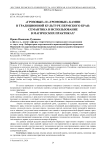
Статья научная
В статье приведены и проанализированы материалы (лексика и тексты), посвященные так называемым «громовым» и «грозовым» камням, которые жители Пермского края используют в магических практиках. Рассмотрение «каменной» семантики номинативного сочетания громовая стрела, наиболее часто используемого для обозначения такого камня, привело к заключению, что значение лексической единицы сложилось в результате метонимического переноса названия с атмосферного явления (молнии) на предмет, в который молния ударила (камень). Мифологизация грозы, грома, молнии обеспечила осмысление камня громовая стрела как обладающего сверхъестественными свойствами. Анализ контекстов записей диалектной речи, сделанных в сельских населенных пунктах Пермского края, позволил выделить для составных номинаций, рассматриваемых в статье (грозовой камень, громовой камень, грозовая стрела, громовая стрела), несколько групп значений в зависимости от наличия / отсутствия связи семантики этих единиц с метеорологической сферой: камень, представляющий собой сплавленный от удара молнии песок - фульгурит; камень, в который ударила молния; камень темно-красного, бурого цвета; гладкий камень округлой формы; камень конической формы, представляющий окаменелые остатки вымерших головоногих моллюсков - белемнит; кусок экзотического дерева; кусок металла вытянутой формы. По данным записей русской диалектной речи Пермского края можно говорить о нескольких сферах использования таких камней: прежде всего они применяются в народно-медицинских целях (для лечения людей и скота), ими могут пользоваться пастухи в апотропеических целях (для охраны скота от хищных зверей). По данным других территорий, громовая стрела может применяться с продуцирующей целью.
Бесплатно
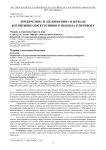
"Прекрасное" и "безобразное" в зеркале когнитивно-дискурсивного подхода к переводу
Статья научная
Данная статья является результатом применения когнитивно-дискурсивного подхода к переводу художественных произведений на примере выполненного авторами перевода с испанского языка на русский рассказа Марио Бенедетти «Ночь уродов» (Mario Benedetti «La noche de los feos»). В качестве адекватного способа структурной организации концепта рассматривается фрейм, при этом анализ семантических корреляций между языковыми репрезентантами концепта позволяет построить ментальную схему содержательно-образной материи исходного текста. Определены ключевые для данного произведения концепты, а именно BELLEZA (красота) и FEALDAD (уродство), через которые, согласно результатам исследования, автором художественного произведения транслируются эстетические категории прекрасного и безобразного. Обращение к де-финиционному и компонентному анализу языковых репрезентантов, наполняющих слоты данных концептов, дало возможность проследить типы семантических связей между ними и способствовало сохранению логики авторского повествования при переводе. По итогам проведенного исследования делается вывод о том, что когнитивно-дискурсивный анализ, моделирование концептосферы рассказа и фреймовый анализ основополагающих концептов, заложенных автором, могут быть использованы как эффективный метод решения проблемы понимания и интерпретации текста. Данная методика предпереводческого анализа художественного произведения позволяет обосновать принятые переводческие решения и осуществить перевод художественного произведения с позиции, наиболее приближенной к авторской.
Бесплатно
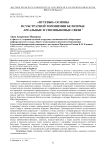
"Путевые" основы в субстратной топонимии Белозерья: ареальные и этноязыковые связи
Статья научная
Рассматриваются основы со значениями 'перешеек, волок', 'путь, дорога', регулярно повторяющиеся в субстратной топонимии Белозерья и маркирующие пути передвижения. В исследовании ставится задача выявления корпуса топооснов с указанной семантикой, установления мотивации; осуществляется попытка интерпретации их географического распространения и определения наиболее вероятной этноязыковой принадлежности. Целью исследования является уточнение этноязыковых характеристик субстратной топонимии Белозерья. В качестве источника материала используются данные картотек Топонимической экспедиции Уральского федерального университета (Екатеринбург) и Картотеки топонимов Института языка, литературы и истории Карельского научного центра РАН (Петрозаводск). В аналитической части статьи предлагается стратификация рассматриваемых топонимических основ с точки зрения происхождения. На базе словарей вепсского, карельского, финского, саамского и марийского языков, а также с привлечением уже опубликованных исследований по топонимии Русского Севера и смежных регионов (Карелии, Финляндии, Ленинградской области) осуществляется направленный поиск параллелей - топонимов с той же основой. С позиций ареально-типологического метода анализируются основы, имеющие прауральское (*ukti, *taj-), прибалтийско-финское (matk, ura), западное прибалтийско-финское (rata, polku) и марийское (корно) происхождение. На основании ареальных связей выявленных географических названий и распространения основы в финно-угорских языках (прибалтийско-финских, саамских, волжско-финских), а также наличия соответствующих лексем в диалектах русского языка делаются выводы о специфике топонимического субстрата Белозерья. Отмечается несколько случаев семантического калькирования: оз. Ухтомьярское и р. Маттерка (Ухтома), р. Маткинец и р. Корнома; оз. Волоцкое и р. Ухтомка; а также «скопления» «путевых» топонимов - на водоразделах и при номинации соседних притоков.
Бесплатно
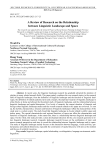
A review of research on the relationship between linguistic landscape and space
Статья научная
In recent years, the linguistic landscape research has gradually attracted the attention of scholars in many related research fields. This paper mainly combines the core research topics in the research field of linguistic landscape, from the definition of linguistic landscape and the function of linguistic landscape, the definition of related academic terms and concepts, the empirical research of linguistic landscape in urban blocks at home and abroad, the theoretical study of linguistic landscape, and the relationship between linguistic landscape and spatial dimensions. Five levels of research, the current situation of domestic and foreign urban linguistic landscape studies and the overall research related to this paper are reviewed. To sum up, the stylistic characteristics, structure and function of linguistic landscapes reflect the characteristics of the study area to a certain extent. The study found that linguistic landscape is closely related to public space and indoor space. The special characteristics and regional functions of space can affect the characteristics and functions of linguistic landscapes. At the same time, there is a relationship between linguistic landscape and space. On the whole, this study provides a clear development direction for the core research questions in future linguistic landscape research. Linguistic landscape research focuses on the combination of micro and macro research perspectives and aims to reveal the relationship between linguistic landscape and its space. The study of linguistic landscape mainly focuses on the interaction between language, visual activities, spatial practice and cultural dimensions, especially the construction of spatial discourse with text as the medium and the use of symbolic resources.
Бесплатно
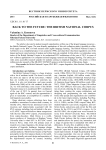
Back to the future: the British national corpus
Статья научная
The article is devoted to student research opportunities within one of the largest language resources – the British National Corpus. The user-friendly annotations of this rich collection make it possible to effectively apply to the BNC for both research and English language learning. The British National Corpus is well-known as a completed project, it was created in 1990s, and since then it has been regarded as one of the largest and most varied corpora of spoken and written data yet compiled. In this article, we reintroduce some issues of the British National Corpus in its modernized BYU architecture of the year of 2012, in sense of new software applications for computer-assisted language research and language learning. The article provides some accessible research samples for students coming to empirical linguistics. The article is written within post-doc research of the ERANET MUNDUS project, at the University of Barcelona, Spain.
Бесплатно
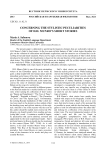
Concerning the stylistic peculiarities of H.H. Munro's short stories
Статья научная
The present paper is devoted to the analysis of stylistic devices which play an important role in H. H. Munro’s (Saki’s) short stories. The author singles out two main stylistic patterns in Saki’s short stories: distortion of collocations and idiomatic expressions, and extensive use of formal lexis in describing trivial and banal situations. There are five types of texts in the classification of Saki’s short stories introduced in the article; the classification is based on the role and function of the marked units used in the short stories. The stylistic patterns of Saki’s prose are in keeping with the aesthetic tendencies reflected in the works by O. Wilde, A. Beardsley, R. Firbank and other authors.
Бесплатно
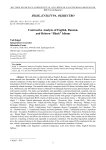
Contrastive analysis of English, Russian, and Hebrew “black” idioms
Статья научная
The work aims to collect and analyze English, Russian, and Hebrew idioms with the lexeme black/черный/ שחור (hereinafter - BLIS). It is the first study implementing the collection of Hebrew idioms and the comparison of these three languages as the subject of scientific research. The article proposes a systematization of BLIS based on microsystems consisting of meaning associative chains with logically and semantically related meanings. The material under study comprises about 440 idioms (including about 180 English, 160 Russian, and 100 Hebrew idioms) collected from trilingual electronic lexical, phraseological sources, and Internet searches. The study used qualitative and quantitative contextual-functional, semantic, and cultural- linguistic analyses within the lingua culturological approach. After compiling lists of idioms, identifying their meanings, and comparing them, the author created a table with groups of equivalent and unique BLIS. The microsystem of equivalent BLIS consists of three groups of associative chains: 1. The optical color of the object. 1.1. Nature. Natural phenomena, physical objects - Resources; Flora - Fauna; Body - Skin color. 1.2. Human activity. Etalon color - Black and white image; Clothing: Official - Mourning - Military; Food, beverages; Medicine - Drugs; Board games - Competition - Sports; Hybrid war: Disinformation - Secret operations; Economy - Profit - Employment; Vote; Computers, devices; Typography; Art: Literature - Music - Morbid Humor. 1.3. Intellectual, mental, and moral problems. Clarity - intellectual activity; Unpredictable event - Exception; Prohibition versus permission; Unsuccessful, Difficult - Depression, Pessimism; Ruinous - Illegal; Magic. The proposed classification covers physical, mental characteristics, and a large number of human activity areas, and allows the inclusion of new BLIS in the future. These results can be effectively used in L2 teaching, in human and especially in automatic translation. The described equivalent metaphors prove the common features in the linguocultural picture of the world, and unique BLIS complement this picture, which is important for intercultural communication and automatic translation of idioms.
Бесплатно
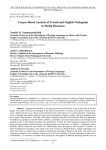
Corpus-based analysis of French and English neologisms in media discourse
Статья научная
Language development is an ongoing process, and changes occur at all levels of the language. This article discusses the changes in the lexical composition of French and English, namely neologisms. Media discourse was chosen as the material for the study because it is characterized by a high dynamism of changes and reflects, interprets many new phenomena of objective reality, with new language structures used to describe them. The study was based on linguistic data from Néoveille and WebCorp platforms. In addition to quantitative and distributive methods, a qualitative and component analysis of neologisms was applied to their word-formation models and connotations. In 2022 the most frequent neologisms in French were personnes-années, demies-journées, grande-reporters, and tout-mots, in English - liveaboard, micromobility, effective altruism, and tomato flu. Additionally, some neologisms were analyzed in context. In 2022 metaphorical neologisms were found to be more common in English than in French. Neologisms appear more often in contexts that are related to technology and politics. Based on the study, lists of the most common neologisms were compiled, which can be used in the teaching of foreign languages at high levels. Undoubtedly, it is necessary to further study neologisms that appear in different languages and the ways of detecting them in various texts because, despite the high level of development of the tools of computational and corpus linguistics, their methods and tools still have limitations and shortcomings that require an expert assessment of the results obtained.
Бесплатно

Don’t omit –s!: a common grammatical error of Chinese speakers of English
Статья научная
The paper presents an analysis of the common grammatical error of Taiwanese students in oral English, namely the omission of the final suffix -s in its three grammatical functions, especially in the 3 rd person singular. The major causes of this error are studied in this paper and further divided into two main categories, the grammatical and phonetic one. The omission of -s is primarily considered as interference error or “negative transfer” caused by non-inflectional nature of the Chinese language. In the article, the author emphasizes a role of the teacher in the selection of a suitable teaching method for this grammatical rule considering the phonological features of the final bound, inflectional morpheme -s in English, and linguistic features of the native language.
Бесплатно
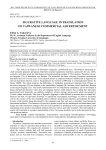
Figurative language in translation of Taiwanese commercial advertisement
Статья научная
This study is an analysis of Taiwanese companies’ promotional texts. The products advertised include computer programs and games, high-tech computer equipment, machinery, spare parts for cars, LEDs, cosmetics, and other goods for distribution in Russian-speaking markets of CIS countries. Therefore, the target language (TL) of translation was Russian. The researcher has been collecting Taiwanese promotional translation texts for over ten years. This research utilizes an empirical inductive method and is supported by relevant translation theories such as Skopostheorie by Vermeer [1989] and re-contextualization theory by House [2008]. The article analyzes the difficulties in translating promotional materials from Chinese as the source language (SL) into English as the intermediary language (IL) and then from English into Russian as the target language (TL). The article demonstrates how an intercultural competence can be developed in doing international business when there are language barriers. Data analysis has revealed that Taiwanese promotional texts frequently use epithets, metaphors, idioms, sayings and proverbs which are integral to Chinese culture and speech. This type of figurative language is often difficult to translate due to cultural differences and lack of equivalent meanings or insufficient encyclopedic knowledge. In order to accurately convey the essence of the text translated, deliver effective promotional materials, and maintain the attractiveness of the product being advertised for the companies and their end users, a translator must become an intercultural mediator. This research will provide a greater insight into the interlingual and intercultural challenges and offer translation strategies that can assist translators in producing more accurate translations and maintaining more positive intercultural relations between Taiwan and other countries. This intercultural research will contribute to a greater understanding of how Taiwanese products can be better promoted in Russian-speaking markets.
Бесплатно
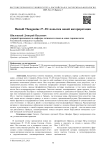
Hesiodi Theogoniae 27–28: попытка новой интерпретации
Статья научная
Загадочные «многие неправды, похожие на правды», наряду с собственно «правдами», которые могут говорить Музы стихов 27–28 поэмы Гесиода «Теогония», вызвали к жизни немалое количество интерпретаций, что само по себе сообщает об отсутствии окончательно удовлетворительного понимания данного места. Оно получает приемлемое объяснение, если допустить, что в знаменитой реплике богинь под «многими неправдами» автором подразумевались изначально двусмысленные ответы, данные Дельфийским Оракулом, которые по-разному, в том числе ошибочно, могли быть интерпретируемы смертными. Гипотеза находит подтверждение, среди прочего, в прямом свидетельстве Плутарха о непосредственном отношении к деятельности Оракула Муз, бывших при нем «помощницами в гаданиях». Удивительно почти дословное совпадение знаменитой реплики Муз с текстом гомеровского гимна к Гермесу, где пчелиные девы, обучившие бога искусству гаданий, также могли «говорить правду», а могли и «лгать», предсказывая будущее. Предложенное понимание фрагмента поддерживается также значительным количеством совпадений и соответствий текстов «Теогонии» и «Трудов и Дней» и стихотворных ответов Дельфийского Оракула. Рассмотренный материал и произведенные наблюдения позволяют говорить о некоем общем пространстве эпической поэзии, куда входили, с одной стороны, творчество эпических поэтов, с другой – так или иначе понятая деятельность Оракула, гекзаметрические ответы которого имеют безусловное отношение к устной эпической поэтической традиции.
Бесплатно
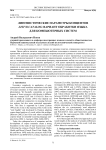
Статья научная
In this case study we present two near-synonymous concepts which reflect the human outlook. The aim of this work is to define the most appropriate one for its usage in the further investigations on semantics of ordering and enumerative units. Being unconscious and objective, these units exist irrespectively of the observer and can be defined by distinctions and oppositions. From this point of view we get LIST and CATALOG as near-synonymous words seeking to identify the factors that determine the choice of a concept by objective and semantic criteria. For this purpose we elaborate an outline of multiple logistic regression analysis. The focus of investigation is on the identification of the contents and dynamics of the concepts verbalized by LIST and CATALOG across (1) four registers of the language (academic, spoken, fiction, newspaper), (2) semantic feature of possessive meaning, (3) plural modification, (4) post-modification, (5) pre-modification and (6) genitive meaning.
Бесплатно
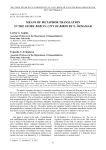
Means of metaphor translation in the story "Berlin, city of birds" by E. Ozdamar
Статья научная
The article examines the aspect of metaphor translation from German into Russian in the story Berlin, City of Birds by E. Ozdamar, which is done through a cognitive metaphorological approach. It is concerned with the problem of metaphor interpretation as one of the most challenging issues of the theory and practice of translation. The work analyzes metaphor and means of its translation in the framework of conceptual metaphor theory put forward by G. Lakoff and M. Johnson in 1980 and developed further to be applied to a broad range of linguistic phenomena. Metaphor modelling is considered the principal means of conveying the cognitive dominant of the story represented by the two main images of the story, those of Berlin and birds being newcomers to the city. The author employs the metaphor model to depict the city as a motionless photograph that is restored to life due to the advent of birds. The means of metaphor translation include full translation, lexical, morphological and syntactical changes, and omission or addition of lexical units.
Бесплатно
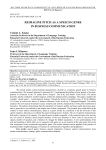
Reimagine pitch as a speech genre in business communication
Статья научная
The article studies system-forming characteristics of pitch as a business speech genre in business communication. The research material is presented by 54 entrepreneurial pitches (a brief speech of an entrepreneur to investors) in the TV reality shows Dragons ’ Den (UK) and Sharks Tank (USA). The article describes pitches studied by modern linguists within the anthropocentric paradigm. The paper considers the concepts ‘speech genre’, ‘communication strategy’ through the prism of scientific views of M. M. Bakhtin, O. S. Issers as well as the theory of business discourse in the works by F. Bargiela-Chiappini. The article analyzes the most typical structural, lexical, semantic and stylistic characteristics of the pitch manifested in dynamics. The authors demonstrate that the interaction of business, public and mass media discourses generates a genre that is not reduced to the simple sum of their components. The research shows that taken in the context of mass media communication, pitch as a genre should be considered in all the diversity of this speech situation, allowing us to rethink the genre-forming factors of pitch. The set of specific characteristics that make it special in its capacity of a speech genre includes inequality of the communication role and status, two pools of listeners, preset logical structure of the text, elements of show, turns in the process of speech, number of speakers, and a function of a trigger for further negotiation. A new understanding of the role and meaning of pitch allows us to categorize this genre not as an element of the sales genre but as the first component of the commercial negotiation genre. The results obtained can be applied in the practice of teaching modern English language, in research on communicative linguistics and pragmatics.
Бесплатно
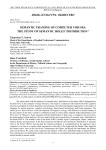
Semantic framing of computer viruses: the study of semantic roles' distribution
Статья научная
The article deals with the problem of semantic roles' distribution in the frame VIRUS designated by the term virus in the computer virology discourse. The study is conducted in the framework of the cognitive discursive paradigm of modern linguistics and comprises the following linguistic approaches to the studies of language for special purposes: cognitive terminology, frame-based terminology, and frame semantics. The article gives a brief overview of the development of computer virology with reference to mental framing of the key aspects in the field. A frame is considered as part of context and a situation model representing a real-life event. Ch. Fillmore's frame semantics and the identification of deep cases or semantic roles are used as the main method of data analyses. We have analyzed the most typical plans of semantic roles' distribution in the frame VIRUS. The semantic roles of the frame VIRUS include Agent, Counteragent, Object, Addressee, Patient, Result, and Instrument. It has been found that besides the most distinctive distribution of semantic roles in the frame VIRUS, showing that the malicious program is conceptualized as the aggressor and a computer or its user as a victim, which correspond to the roles of the Agent and the Patient, there might be the frames with a virus in the role of the Counteragent, the Object, the Result, the Instrument, the Patient, and even the Place. We come to the conclusion that analysis of the roles' distribution helps to determine relations among the event participants and the way the situation is conceptualized and represented in the form of mental models in human minds. In the Discussion section we illustrate the occurrence of typical semantic frames in popular culture, namely in films and television programs. With these we prove the relevance of the approaches and methods chosen to reveal the peculiarities of conceptualization in special areas and connection synergies between language, thought, and communication.
Бесплатно
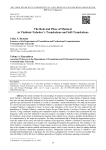
The role and place of metatext in Vladimir Nabokov’s translations and self-translations
Статья научная
The article considers the role and place of metatext in translations and self-translations by Vladimir Nabokov. Although the functions of metatexts have been the focus of a large number of linguistic studies, they have not been thoroughly analysed yet in the context of translation. The purpose of our study was to investigate the types and functions of metatext as a result of a translator’s metacommunication. We analysed the translator’s forewords and commentaries in Vladimir Nabokov’s translation of Alexander Pushkin’s Eugene Onegin and compared Nabokov’s approach to those of eleven other translators of the novel. We also analysed the selftranslations of Vladimir Nabokov’s memoirs Drugie Berega (Other Shores), Conclusive Evidence, and Speak, Memory. Using continuous sampling and comparative analysis methods, we selected and systematised 665 text fragments, which were then subjected to discourse analysis. According to Nabokov’s idea of faithful translation, the translator’s task consists in rendering the meaning of the original text as closely as possible and facilitation of its comprehension by the target text recipients. The study demonstrated that to bridge the linguocultural gap between the author of the source text and the recipients of the target text, Nabokov considered it necessary to provide the readers with metatext as an explicit way of guiding the recipients through the text. The metatext in Vladimir Nabokov’s translation of Eugene Onegin stands out due to its scrutiny and an in-depth analysis of the structure of the original text and its cultural and historical context, which, in turn, served as a basis for making brilliant (although sometimes disputable) translation decisions. Metatextual inclusions observed in Nabokov’s selftranslated autobiography and, in particular, the way they are changing from version to version convincingly illustrate his ability to tell his life story to different generations of English- and Russian-speaking communities.
Бесплатно
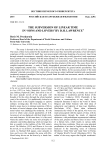
The subversion of linear time in 'Sons and lovers'' by D.H. Lawrence
Статья научная
The essay is devoted to the issues of art time in one of the most known novels of D.H. Lawrence. The issues of time were central for the modernist writers since they showed the prevalence of an individual's experience of life over the life itself; they were preoccupied with proper depicting of a person's inner living through external circumstances, especially when a young hero enters the world, perceives it and experiences heavy growth costs as it happens with the main character of 'Sons and Lovers'. The novel under analysis is constructed on the basis of several genetic plot patterns: socio-panoramic, biographical and autobiographical and psycho-analytical, and each of them influences the time-structure of the novel. The essay shows how a complex temporal structure - a unity of family, biographical, personal time and socio-historical time, epic time, transpersonal, eternal time - works in the novel and determines its general artistic peculiarities. The author argues that D.H. Lawrence, for the purpose of giving the fullest, by his account, picture of the main character's internal conversion of the events of his growing up, unites traditional (realistic) and experimental (modernist) temporal paradigms, having kept general linear forward time-movement, retards, or/and hastens the flux of narrated time.
Бесплатно

Статья научная
Up-to-date information plays a crucial role in modern linguistic research. For this reason, computational linguistic methods, including those aided with analytical and machine-learning tools, are attracting growing attention. Some of their applications in cognitive-discursive linguistics are keyword extraction, topic modelling, and content analysis. Text-mining tools facilitate time-consuming linguistic work and add to the results’ reliability and greater statistical precision by processing a significantly larger data volume. Most studies, however, have overlooked interference of socially significant but context-irrelevant (e.g. political) information into a specialized discourse by focusing mainly on one data format. The current study, aimed at topic modelling, has been carried out on the computer security discourse. We have implemented the project on the KNIME analytical platform. The model enables comparison between topics extracted from published articles and date-specific RSS news feeds. The study provides important insights into infodemiology and political incidental news exposure occurring in computer-security-oriented RSS feeds on the Kaspersky website but untraceable in the papers published on the same website in a PDF format. The results reported here provide further evidence for the need to consider the hypercontext of professional communication and employ real-time data in solving similar problems within cognitive-discursive linguistics. Our contribution to the development of cognitive-discursive linguistics is the method for comparing topics within one discourse, taking into account near-real-time data. For computational linguistics, the significance of our work lies in describing a new application of the topic extraction workflow freely available on the KNIME hub.
Бесплатно
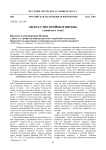
«Искусство кройки и шитья» (заметки к теме)
Статья научная
Объектом анализа в статье является образ портного в литературе (начиная с первого портного - Адама), что не подразумевает исследования всех текстов, содержащих этот образ, но позволяет выявить некоторые черты, характерные для его эволюции. Два типа, отчетливо сформировавшиеся в литературе, - это «портной» и «портняжка». «Портняжка» - маленький, но храбрый подмастерье, готовый променять ремесло на власть и славу; «портной» - бедняк и пьяница, верный своей профессии, жаждущий богатства, снимающий одежду со своего клиента в прямом (Гримм) и метафорическом смысле (Андерсен). «Портняжка - характер, «портной» - способ проникновения в суть вещей. «Портняжка воплощает героизм, «портной» - рутину быта. «Портняжка преуспевает благодаря удаче, «портной» получает материальную выгоду с помощью волшебства. Жизнь «портняжки» зависит от случая, «портного» - от судьбы. Портной - человек искусства, хозяин жизни и смерти: мастерство называется «делом», что порождает языковую игру: шить одежду - шить дело. Перешив одежды чреват сменой судьбы. Образ «портного» - символ трагического несоответствия ожиданий и их реализации. Потенциальная способность к «перекраиванию» мира не спасает портного от роли жертвы.
Бесплатно
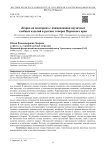
«Корка на подпорках»: наименования неудачных хлебных изделий в русских говорах Пермского края
Статья научная
В статье рассматриваются пермские диалектные наименования неудачных хлебных изделий. В пермских говорах отмечено большое количество слов, называющих подобные пищевые продукты, что свидетельствует о повсеместном распространении домашнего хлебопечения, при котором случались различные кулинарные ошибки. Характеристики и номинации неудачных выпечных изделий свидетельствуют о важности для носителей диалекта таких свойств выпечки, как вкус, консистенция и форма. В статье проведен анализ указанной группы лексики в семантико-мотивационном аспекте с целью определения особенностей формирования рассматриваемой лексической группы, выявления возможных заимствований, этимологической реконструкции лексем с «непрозрачной» внутренней формой. В этой группе лексики преобладают образные, экспрессивные единицы; часто для характеристики непропеченной, неподнявшейся, подгоревшей выпечки используются фразеологические сочетания и выражения, сравнительные конструкции, метафоры. Во многом данным фактом обусловливается численный перевес собственно пермской диалектной лексики в группе с этим значением. Появление некоторых лексем оказывается результатом заимствования из пермских (коми и коми- пермяцкого) языков. Эти единицы отмечаются в северных говорах Прикамья, так как на территории их бытования были наиболее тесные контакты с коми населением. Приготовление хлеба и другой выпечки являлось одной из важных обязанностей женщины в крестьянском хозяйстве, свидетельствовало о ее качествах хозяйки. Поэтому для характеристики неудачных выпечных изделий иногда используются выражения, указывающие на ошибки женщины-пекаря.
Бесплатно

